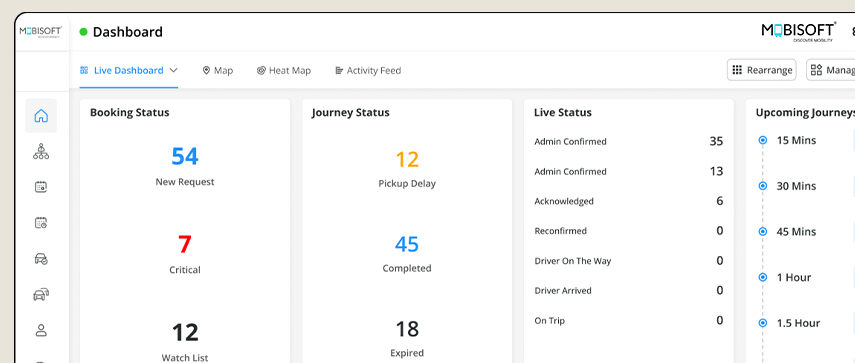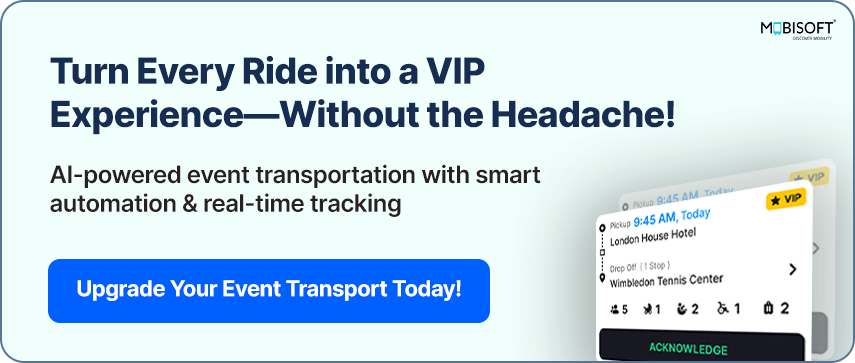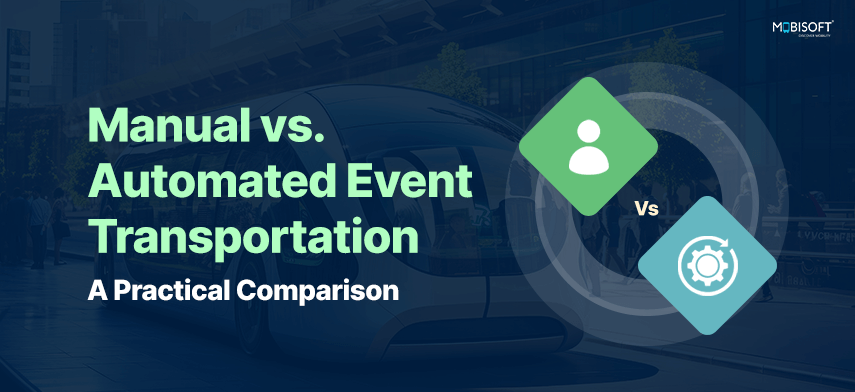Transport can make or break the experience at a big event. Whether it's a sports tournament, business summit, or festival, how smoothly people get from place to place matters more than you think.
Let’s say you’re organizing a global sports tournament spread across multiple venues in a city. With a manual system, your transport team juggles WhatsApp groups, spreadsheets, and constant calls to coordinate hundreds of vehicle movements. One missed update leads to a VIP arriving late, while drivers assigned to the wrong venue lose valuable time backtracking. Confusion builds and stress levels rise.
Now contrast that with an automated event transportation system at events. Drivers receive real-time route updates via their app. Dispatchers can view all vehicle locations on a single dashboard. Attendees get timely SMS or WhatsApp notifications about vehicle arrivals. Instead of reacting to issues, your team focuses on running the event smoothly.
So which setup is right for your event? Let’s take a closer look at manual vs automated event transportation.
Understanding Manual vs. Automated Event Transport
Manual Event Transportation - Where It Falls Short

Manual event transportation planning depends heavily on human coordination. Teams often use spreadsheets, printed schedules, radio calls, and phone communication to assign vehicles, track routes, and respond to changes. While this method may work for small or straightforward events, the cracks start to appear as the scale or complexity increases.
Key challenges with manual systems:
- Slow response to changes: Any update in route or schedule often relies on phone calls or radio, leading to delays.
- High dependency on staff: Every vehicle assignment or reroute needs human intervention.
- Miscommunication risks: With multiple teams and moving parts, it’s easy for information to be lost, delayed, or misunderstood.
- Difficult to scale: Managing hundreds of rides manually becomes unmanageable without real-time visibility.
- Poor attendee experience: Delays, unclear instructions, and mismanaged pickups create frustration for attendees and VIPs alike.
Even tasks like managing pickups for VIPs, assigning the right vehicle types, or adapting to last-minute changes can feel like firefighting when done manually.
Also read - The True Cost of Poor Event Transportation: Lost Time, Revenue and Reputation
Automated Event Transportation - A Smarter Way Forward

Automated event transportation systems bring structure, speed, and scalability to event logistics. Instead of juggling phone calls and spreadsheets, event teams use a central platform to manage everything from vehicle assignments to route changes and live tracking.
Key advantages of automated systems:

- Real-time Updates: Route changes, delays, or pickups are instantly reflected across all stakeholders, reducing confusion.
- Smart Scheduling: Vehicles and drivers are automatically assigned based on demand, availability, and location, minimizing idle time.
- Live Tracking: Organizers, dispatchers, and attendees can track rides in real-time, improving visibility and reducing uncertainty.
- Fewer Manual Errors: Automation reduces the risk of missed pickups or duplicated efforts.
- Scalable Operations: Whether it’s 50 guests or 5,000, the system adapts to handle increased volume with ease.
- Better Experience For All: Clear communication, timely pickups, and smooth coordination translate to happier guests, VIPs, and team members.
For multi-day, multi-venue events, especially, automated transportation solutions provide the level of control and efficiency that manual methods simply can’t match.
Cost Savings: Companies adopting automated fleet management services have reported cost savings of up to 50% when implemented strategically. [Source]

Key Differences: Manual vs Automated Event Transport
Understanding the nuances between manual and automated event transportation solutions is crucial for making an informed decision. In this section, we’ll break down the key differences in areas like efficiency, scalability, and cost-effectiveness, providing a clear comparison of how these two systems stack up in real-world event scenarios.
Efficiency & Speed
Manual systems rely on human coordination, often leading to delays and errors when plans change.
Automated platforms
Instantly adjust routes, dispatch vehicles faster, and reduce response times during high-pressure moments.
Cost & Resource Allocation
Manual coordination requires a larger team on the ground, which adds to labor costs and increases chances of operational friction.
Automated systems
Streamline staffing needs, improve vehicle utilization, and can significantly lower operational costs over time.
Data Privacy & Security
Manual systems may lack structured protocols for handling sensitive data like VIP schedules, trip logs, or personal contact details.
Automated transport systems
Keep sensitive data safe with secure storage, login controls, and encryption. They also follow data privacy rules like GDPR, giving both organizers and attendees peace of mind.
Also Read - Data Privacy and Safety First: Essential Guidelines for Secure VIP Transportation
Data-Driven Decision Making
Manual processes rarely offer reliable insights after an event.
Automated platforms
Provide clear reports on vehicles, drivers, vendors, timelines, and passenger feedback. These insights help organizers spot issues, improve operations, and plan better for future events.
Scalability
Manual systems are hard to scale for large events. Without real-time tracking, managing hundreds of trips across multiple venues often leads to delays, confusion, and traffic issues.
Automated systems
Handle large crowds with ease. They adjust in real time and scale effortlessly, whether it's a multi-day conference or a city-wide event, all while keeping operations smooth and organized.
The Benefits of Automated Event Transport

Automated transport solutions offer more than just cost savings. They help event organizers plan smarter, move people faster, and make better decisions using real-time data.
- AI-powered route optimization helps reduce traffic by finding the fastest, least crowded routes in real time. It’s been used at major events like the Olympics to keep shuttles moving smoothly and avoid traffic jams during busy hours.
- Real-time tracking and automated notifications keep attendees informed about their rides. Guests can check live updates on their phones, reducing wait times and making their schedules more efficient.
- Data-driven decision making has changed event transportation. By using predictive analytics, organizers can predict peak travel times, plan vehicle allocations in advance, and avoid last-minute rushes. At CES 2024, organizers used data to manage shuttles based on expected crowd movement, ensuring smoother operations.
- Cost efficiency and sustainability are also key benefits of automated systems. They reduce idle time, optimize vehicle loads, and cut fuel use, keeping costs down. Using electric or hybrid vehicles also supports sustainability goals, helping organizers lower their carbon footprint while keeping operations efficient.
When Does Manual Transportation Still Make Sense?
Despite the advantages of automated systems, manual transportation may still be the best choice in certain scenarios:
- Small events with fewer attendees: For events with simpler logistics, coordinating a small number of vehicles and routes can be effectively managed without software systems.
- Personalized concierge services: When high-level personalization is required, such as for VIP or VVIP events, a manual system allows for hands-on management, ensuring tailored transportation experiences for guests.
- Locations with limited tech infrastructure: In remote areas with unreliable GPS or mobile networks, manual transportation ensures smooth operations where automation may not be practical.
Also Read - Essential Factors to Consider When Choosing An Event Transportation Management Solution
Final Thought:
Technology is reshaping how event transportation works – and for good reason. With tools like real-time tracking, dynamic route planning, and automated scheduling, things just run smoother. If you’re looking to make your next event less stressful and more seamless, it might be time to explore what automation can do for your transport planning.
Need help optimizing your event transportation? Let’s talk about how automation can streamline your next big event.





 March 12, 2025
March 12, 2025


